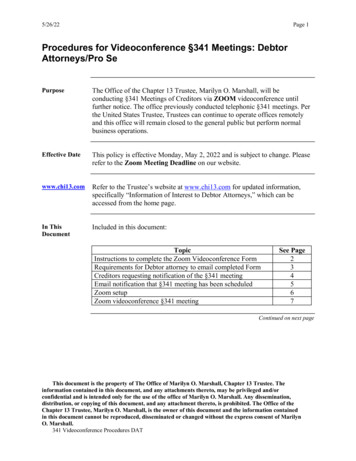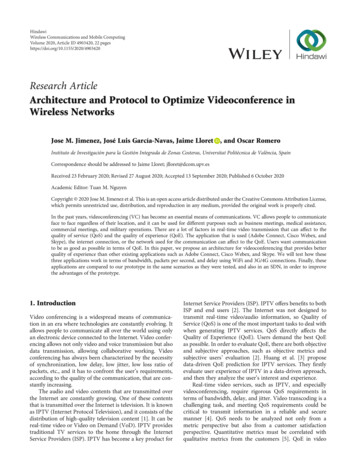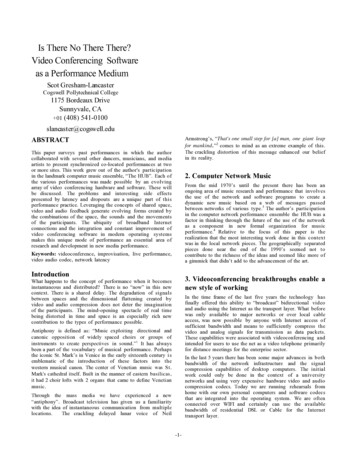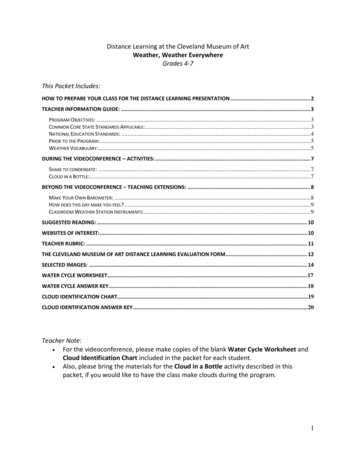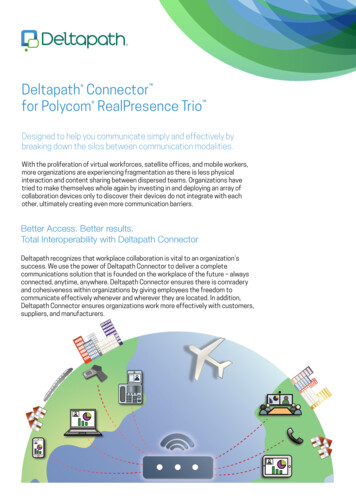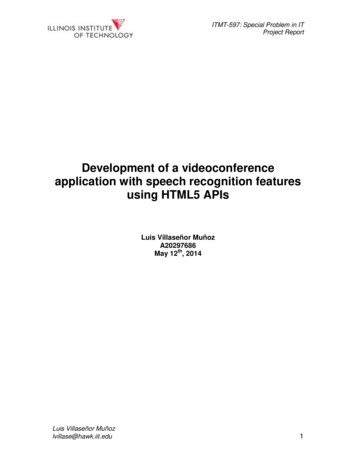
Transcription
ITMT-597: Special Problem in ITProject ReportDevelopment of a videoconferenceapplication with speech recognition featuresusing HTML5 APIsLuis Villaseñor MuñozA20297686May 12th, 2014Luis Villaseñor Muñozlvillase@hawk.iit.edu1
ITMT-597: Special Problem in ITProject ReportAbstractThis paper describes the development process of a real-time videoconferenceapplication with features related to speech recognition including real-time captioning,transcription storage and instant translation.Among other things, this paper include details on how the WebRTC web API was usedfor developing a multi-user videoconferencing application and how the HTML5’s WebSpeech API was used for providing real-time captioning.Luis Villaseñor Muñozlvillase@hawk.iit.edu2
ITMT-597: Special Problem in ITProject ReportTable of ContentsAbstract. 2Table of Contents. 31. Introduction . 42. Project description . 52.1. Goal . 52.2. Milestones . 53. Requirements . 63.1. Equipment . 63.2. Node.js . 73.3. Google Chrome . 74. Development. 84.1. Web server . 84.2. index.html . 94.3. Multi-user WebRTC application . 94.4. Real-time captioning . 174.5. Transcription storage . 194.6. Instant translation . 204.7. Spoken translated subtitles . 224.8. Appearance . 225. Next steps . 246. Conclusions . 26Acknowledgements . 27References . 28Appendix . 30A. HTTP server and HTTPS server implementation code . 30Luis Villaseñor Muñozlvillase@hawk.iit.edu3
ITMT-597: Special Problem in ITProject Report1. IntroductionWeb technologies have experienced a major development during the last years. Thepower and versatility demonstrated by these technologies point the browser as theappropriate platform for the development of a new breed of applications. No need ofinstallation, always updated and available worldwide, are some of the advantagesinherent to this kind of applications.Included as one more API of the HTML5 specification, the WebRTC web API enables webbrowsers with real-time communications capabilities using simple JavaScript. AlthoughWebRTC is still under development, it has already shown a great ability establishing highquality videoconferences. In May 2014, WebRTC is compatible with some of the majorbrowser vendors: Google Chrome, Mozilla Firefox and Opera. In addition, the Androidversion of these web browsers are also WebRTC capable.With many WebRTC applications online nowadays, the need of a real-time captioningsolution for these applications in order to be used by hearing impaired people was thefirst motivation for the initiation of this project. Once we explored the Web Speech APIand its possibilities, the goals went further, aiming other possible uses as, for example,instant translation.Luis Villaseñor Muñozlvillase@hawk.iit.edu4
ITMT-597: Special Problem in ITProject Report2. Project descriptionThe project exposed in this paper combines the WebRTC web API, the Web Speech APIand other HTML5 APIs in order to obtain a multi-user videoconferencing applicationable to provide real-time caption and other features related to speech recognition.2.1. Goal“To develop a WebRTC multi-user video conference application with some extrafeatures based on speech recognition as real-time captioning, instant translation andtranscription storage.”2.2. MilestonesIn order to manage the application development in an efficient way, the nextmilestones were established: Multi-user videoconferencing applicationReal-time captioningTranscription storageInstant translationThe development of each of these milestones will be explained later in this document.Luis Villaseñor Muñozlvillase@hawk.iit.edu5
ITMT-597: Special Problem in ITProject Report3. RequirementsThe next requirements are needed in order to use the application.3.1. EquipmentSince the project is a web application, it needs to be hosted in a web server. Acomputer with internet connection and a public IP are needed.These are the characteristics of computer used:Processor:Memory:Operating system:Intel Core 2 CPU 6320@1.86GHz x 23.8 GiBUbuntu Release 12.04 (precise) 64-bitKernel Linux 3.11.0-20-genericGNOME 3.4.2We chose Ubuntu Desktop 12.04 LTS as operating system. This operating system fitsour need of a free operating system with no major compatibility issues and an easy touse interface. Instructions about the download and the installation of this operatingsystem can be found in the official Ubuntu web page[1] listed in the references of thisdocument.This computer used one connection of the VoIP lab’s 109 network. We used the IP64.131.109.59, whose host name is dixie11.rice.iit.edu. You can easily know the IP of aLinux machine by executing the ifconfig command. The hostname of an IP addresscan be found out by executing the host IP address command.Luis Villaseñor Muñozlvillase@hawk.iit.edu6
ITMT-597: Special Problem in ITProject Report3.2. Node.jsThe server part of the application will use Node.js, a software platform for server-sideand networking applications. These applications are written in JavaScript. Since theWebRTC web API is accessed using Javascript, choosing Node.js gives us theopportunity of write everything in Javascript making easier the communicationsbetween client and server. Node.js is available for download at the Node.js website[2].In addition, we have used socket.io, a Node.js module that enables WebSockets. Weuse WebSockets for the message exchange between clients and server. Instructions ofinstallation and usage can be found at the Socket.IO webpage[3].3.3. Google ChromeThe clients must use Google Chrome[4] in order to being able to use all theimplemented features. Although other browsers are WebRTC capable, Google Chromeis the only one that has implemented the WebSpeech API so far. The WebSpeech APIwill be the cornerstone for all the speech recognition features.Luis Villaseñor Muñozlvillase@hawk.iit.edu7
ITMT-597: Special Problem in ITProject Report4. DevelopmentThe next sections explain in detail the development process of every functional elementthat was implemented for the completion of the project.4.1. Web serverIn this section we will explain how the HTTP and HTTPS request are handled. The codeof the implementation of both servers can be found in the appendix section A. In theappendix sections B and C there are explained some tools that make easier managingthe server.4.1.1. HTTP serverAll the requests received by the HTTP server will be redirected to the HTTPS server. A301 Moved Permanently response will be provided. The HTTP server will take intoconsideration the relative path the request was trying to access redirecting the clientto the same relative path in the HTTPS server.- Example:http://dixie11.rice.iit.edu/room room1 https://dixie11.rice.iit.edu/room room14.1.2. HTTPS serverThe advantage of using a HTTPS server for serving the application is that theapplication doesn't need to ask the user for permission to use his camera andmicrophone every time they had to be used. The application only needs to begranted access once to use them every time they are needed.The HTTPS server will behave as related next:-If the relative path of the requested address is compliant with the application’ssyntax (/room room or /room room &user user ) the HTTPS server willprovide the room.html file where the WebRTC application will start.Luis Villaseñor Muñozlvillase@hawk.iit.edu8
ITMT-597: Special Problem in ITProject Report-If the requested file doesn’t exists or it is one of the protected files (SSL privatekey and SSL certificate) the server will provide a 404 Not Found response andthe user will be redirected to an error page.-Every other existing file requested will be provided along with a 200 OK response.In order to run the HTTPS server, a SSL certificate is needed. Information about howto get one can be found in appendix section D.4.2. index.htmlThe index.html page gives the user the opportunity of indicate his username and thename of the room he wants to join with a form. The initial.js script will verify thatthese fields are properly filled and then it will redirect the user to the room he hasasked.The initial.js script also contains a listener for the enter key so the user can submit theform by pressing this key.4.3. Multi-user WebRTC applicationFor achieving this milestone we have used the MediaStream API and theRTCPeerConnection API included in the WebRTC web API.4.3.1. Connection handlingOnce the user has downloaded the room.html the main.js script will execute. Thisscript contains the client part of the WebRTC application. The typical application flowwill be as follows:1. The application will check if the user has already specified his username. If it isnot specified, the user will be asked for it.2. The user will established a WebSocket connection with the server and willrequest to join the room. All the message exchange between server and clients ismade through WebSockets.Luis Villaseñor Muñozlvillase@hawk.iit.edu9
ITMT-597: Special Problem in ITProject Report3. The server will handle the user request:3.1. If the username is already in use in the requested room the user will be askedfor a different username. The server keeps a list with every user in everyexisting room.3.2. If the username is not in use and the room doesn’t exist, the room will becreated.3.3. If the username is not in use and the room exists, the user will join the roomand the rest of users in the room will be notified that a new user has joined theroom.4. When a user joins a room the application will proceed to get his local stream usingthe MediaStream API.5. When a user receives notice of a new user, he will create a new peer connectionelement, he will attach his local stream to it, and will wait for the other user tostart the offer/answer exchange.6. After joining a room and getting his local stream ready, if there are other users inthe room, the user will create a peer connection element for every one of themand will start the offer/answer protocol in order to establish a peer to peerconnection with each of them.The following ladder diagram exemplify the most important points of the applicationflow for establishing a call between two users:Luis Villaseñor Muñozlvillase@hawk.iit.edu10
ITMT-597: Special Problem in ITProject ReportOnce the connection phase is over there will be a peer to peer connection betweeneach pair of users present in one room, resulting in a mesh network. In addition, wecan have several different rooms simultaneously, so we can have more than onemesh. The next figure exemplify the situation of two rooms with 6 users in eachroom. Limits:Although proper measures of this fact are needed, we have observed that very fewresources were used by the server for maintaining the WebSocket connectionsalive. Neither the processor usage, the memory usage or the bandwidth usage areimportant, so we think that a great number of WebSocket connections can bemaintained at the same time with our current server.4.3.2. MediaStream APIWe use the MediaStream API in order to gain access to the user's camera andmicrophone. As stated in the W3C Editor's Draft titled Media Capture and Streams[5],the MediaStream interface is used to represent streams of media data, typically (butnot necessarily) of audio and/or video content.Luis Villaseñor Muñozlvillase@hawk.iit.edu11
ITMT-597: Special Problem in ITProject Report Usage:For obtaining the user's MediaStream we use the following code:navigator.getUserMedia(constraints, successCallback, errorCallback);Where:constraints:This variable allow us to indicate constraints on theMediaStreamTracks we want to obtain. In our case the value of this variable is:{video: true, audio: true}successCallback: This parameter indicates the function that will be called if thegetUserMedia request is successful. In our case the local video will be attached tothe HTML video element located in the local user area with that purpose and theuser will start calling the rest of the users that have already joined the room.errorCallback: This parameter indicates which function will be called if thegetUserMedia request fails. In this case, the user will be alerted about the error.If the request is successful, we will obtain a MediaStream object as the onerepresented in the picture below. All the MediaStreamTracks inside a MediaStreamobject are automatically synchronized.[6] Figure by Justin Uberti and Sam Dutton.Luis Villaseñor Muñozlvillase@hawk.iit.edu12
ITMT-597: Special Problem in ITProject Report4.3.3. RTCPeerConnection APIWe use the RTCPeerConnection API for establishing peer to peer connectionsbetween users. This API is specifically designed for establishing audio and videoconferences. It is almost transparent for the programmer. Some of their built-induties are: Connecting to remote peers using NAT-traversal technologies such as ICE, STUN,and TURN.Managing the media engines (codecs, echo cancelation, noise reduction.).Sending the locally-produced streams to remote peers and receiving streamsfrom remote peers.Sending arbitrary data directly to remote peers.Taking care of the security, using the most appropriate secure protocol for eachof the WebRTC tasks. It uses HTTPS for the signaling, Secure RTP for the mediaand DTLs for data channel.A diagram showing some of the RTCPeerConnection features and how they areaccessed is next:[7] Figure from WebRTC.org.Luis Villaseñor Muñozlvillase@hawk.iit.edu13
ITMT-597: Special Problem in ITProject ReportMore technical details about this API can be found in the next documents: WebRTC 1.0: Real-time Communication Between Browsers[8]. Javascript Session Establishment Protocol[9]. Usage:During the connection phase the user will create an RTCPeerConnection object forevery user in the room. All these objects are stored in a JSON object using as keythe username of the user for who the object has been created.When creating the RTCPeerConnection objects we specify the application'sbehavior for each of the next events:onaddstream: when the remote stream is added we will create dynamically all theHTML objects required for displaying the remote user's video and his subtitles. Wewill assign custom HTML id tags to each of these elements so we can recover themagain when necessary.onremovestream: when remote stream is removed we will recover the HTMLelements that were used for displaying this stream using the custom id assigned inthe onaddstream event and we will remove them from the view.onicecandidate: when a user receives a new ICE candidate it will be sent to theremote user though the signaling server using WebSockets.ondatachannel: if the data channel is created by the remote user this event will betriggered. The local user will set the data channel up and store it for later use. Wewill send the subtitles through the data channel.In addition, when creating the RTCPeerConnection objects we also specify, if any,the STUN and TURN servers the application will be using for ICE. In our case,depending on which browser is the user using we will choose what server to usebetween Google's STUN, Mozilla's STUN and VoIP lab's STUN. In any case, we willalso use the VoIP lab's TURN for solving difficult connectivity issues caused by NATs.Luis Villaseñor Muñozlvillase@hawk.iit.edu14
ITMT-597: Special Problem in ITProject Report4.3.4. ICE / STUN / TURNICE, STUN and TURN are different mechanism for obtaining possible addresses wherea peer can contact another peer. As stated in the RFC 5245[12], ICE is an extension tothe offer/answer model, and works by including a multiplicity of IP addresses andports in SDP offers and answers, which are then tested for connectivity by peer-topeer connectivity checks. The IP addresses and ports included in the SDP and theconnectivity checks are performed using the Session Traversal Utilities for NAT(STUN) protocol and its extension, Traversal Using Relay NAT (TURN). ICE can beused by any protocol utilizing the offer/answer model, such as the Session InitiationProtocol (SIP).While STUN works most of the times, in some very difficult situations TURN is theonly option. TURN enables the communication between two users that can't findeach other because of NATs by relaying their media. This is very expensive in systemresources. In addition, there are some security flaws. TURN server’s performanceThese are the characteristics of computer used as TURN server:Processor:Memory:Operating system:Intel Core 2 Quad CPU Q9300@2.5GHz x 47.6 GiBCentOS Release 6.3 (Final)Kernel Linux 2.6.32-279.el.x86 64GNOME 2.28.2Although the computer used as TURN server is much better than the one used asweb server, we have observed that due to the amount of load the TURN server hasto deal with, makes this computer insufficient. For instance, if 2 clients need theTURN server for comunicating between them the TURN server will be dealing with 4video streams (1 upstream and 1 downstream for each client). If 3 clients need touse the TURN server for communicating between them, the TURN server will bedealing with 12 video streams (2 uptream and 2 downstream for each client). This istoo much load and only 3 clients are using it. The video the clients received fromthe TURN server will be low quality and it will freeze. The TURN server doesn't scalewell.Luis Villaseñor Muñozlvillase@hawk.iit.edu15
ITMT-597: Special Problem in ITProject Report TURN server’s securityIn order to get access and use the TURN server a password is needed. Since it is theclient the one who should use the TURN server for relaying his media, this passwordshould be in the client side. That means that the password can be easily found byany user that enters the application. This fact is a major security flaw. The TURNserver password should be assigned dynamically somehow in order to improve thesecurity. Reused code:I would like to put on record that I have used code from the WebRTC tutorial[13]written by Sam Dutton for the process of the SDPs during the offer/answerexchange. I followed his tutorial when I started with WebRTC and it didn't makemuch sense to me to re-implement this part in a different way since there are nomany other different ways of implementing that. The functions taken from thatcode are: mergeConstraint, preferOpus, extractSdp, setDefaultCodecand removeCN.4.3.5. Disconnection handlingThe server knows at every moment the state of every client's connection thanks toSocket.IO. In case a user closes the application's tab, the server will be informed andit will alert about it to the rest of the users that remains in the room in which the userthat closed the application was.When a client is alerted about another client's disconnection, all the HTML elementsthat were used for displaying the disconnected user are removed from theapplication view dynamically. In addition, all the variables related to thedisconnected user are removed: RTCPeerConnection object and RTCDataChannelobject.Luis Villaseñor Muñozlvillase@hawk.iit.edu16
ITMT-597: Special Problem in ITProject Report4.4. Real-time captioningFor achieving the Real-time captioning we will use the WebSpeech API for convertingthe user's voice into text and the WebRTC's data channel for sending the text(subtitles) to the remote user that is requesting them.Although the last WebSpeech API specification[10] dates October 2012, GoogleChrome browser is the only browser that supports it. All the features related to speechrecognition exposed in this paper don't work in any other browser at the moment.Chrome uses the same speech recognition service that other Google’s products as theAndroid devices or the Google Glasses use.4.4.1. SpeechRecognition interfaceThe WebSpeech API is composed by 2 interfaces: the SpeechRecognition interface,used for converting speech to text, and the SpeechSyntesis interface, used for turningtext to speech. The SpeechRecognition interface will be the cornerstone of the realtime captioning feature implemented in our application. Usage:As soon as a user joins a room, the application will request his permission foraccessing the camera and the microphone. Since the application is hosted in aHTTPS server the application won't need to ask the user for permission again. Thisenable us to switch on or switch off the speech recognition feature withoutrequesting the user for permission to access the microphone again.We will use the WebSocket connections to redirect remote users' requests forsubtitles to the local user. Once a request for subtitles is received, the speechrecognition will be switched on without the local user intervention. In order to savesystem resources and bandwidth, the subtitles will only be generated if a remoteuser is requesting them.The application will take the browser's default language as the default language forspeech recognition. The user can modify the language used for speech recognitionselecting the desired language inside the dropdown located at the left of thescreen. Only some of the most common world languages have been included in thelist in order to simplify the implementation. More languages can be added easily.Luis Villaseñor Muñozlvillase@hawk.iit.edu17
ITMT-597: Special Problem in ITProject ReportAfter the speech recognition is turned on, the user's voice will be automatically sentto Google's speech recognition service.The application requests interim results. This means that the user will startreceiving his transcribed speech even before of finishing the current phrase. Thanksto this set up, the remote user will feel the subtitles as real-time.The speech recognition feature is event driven. The onresult event will handle theresults of the speech transcription. The results are JSON objects with a list ofpossible matches. We will take the most probable of these possible matches (thefirst one), and we will send it to the users that are requesting subtitles using thedata channel.The results obtained contain an isFinal property that indicates that the phrase iscompleted. The application sends this property along with the subtitles to thereceiving user in order to let him know if it is a final result or if it is just anotherinterim result. The subtitle's text and the isFinal property are encapsulated in aJSON object in order to be sent as text though the data channel.The application has been implemented to keep the speech recognition alive whilesomeone is requesting subtitles, keeping track of all the users that are requestingsubtitles anytime. Although the speech recognition has been set up for requestingcontinuous speech recognition (recognition.continuous true ), Google'sserver will end the speech recognition eventually. The onend event defined in theapplication will call the keepSpeechRecognitionAliveIfNeeded() function whichwill switch on the speech recognition again if needed.4.4.2. RTCDataChannelAt the same time that the application created a RTCPeerConnection element forevery user in the room, an RTCDataChannel element was also created for each ofthem. All these elements are also stored in a JSON object using the remote user'susername as key.We send text though the data channel using the next syntax:dataChannel.send('text');The RTCDataChannel interface is also event driven. The onmessage event will betriggered when a subtitle is received. Then, application will write the subtitle in thecaption space located at the inferior part of the remote user's video element.Luis Villaseñor Muñozlvillase@hawk.iit.edu18
ITMT-597: Special Problem in ITProject Report4.4.3. ArchitectureThe next diagram represent the typical situation in which a user (User A) requestsubtitles from other user (User B):4.5. Transcription storageThe aim of this feature is to store locally, in text format, anything said by anybody in aroom. We use the IndexedDB API for achieving this. The IndexedDB API is also part ofHTML5. We can create simple and easy to use databases using this API. For ourapplication, when the users use it for the first time, a database with the next columnsis created:iddateroomusertextThe database can easily be reviewed under the Resources tab of the Google Chrome'sDeveloper Tools when accessing the application.Luis Villaseñor Muñozlvillase@hawk.iit.edu19
ITMT-597: Special Problem in ITProject Report Usage:The user can turn on or off the transcription storage feature by clicking the On andOff buttons placed at the left of the screen. When the transcription storage feature isturned on the application will request subtitles to all the users in the room and it willalso start the local user speech recognition.When receiving subtitles from the remote users the application will check if thetranscription storage is enabled. If it is enabled, the application will check if thereceived subtitle is a final subtitle before saving it in the database along with the userthat said it, the room, the date and a unique id that is used as the database's primarykey. Checking the isFinal subtitle's property makes possible to store once everyphrase instead of saving each interim result.The transcription of the local speech goes through a similar process when it isreceived from the speech recognition service.For retrieving the stored transcriptions, the user have to click the "Browse storedtranscription link". This link will open in a new tab so, in case there is any conferencein progress, the conference won't finish. The transcriptionStorage.js script will displayall the data stored inside the local database in a table.4.6. Instant translationThe application will translate the requested subtitles from the originating user'slanguage to the terminating user's language using an online translation service.4.6.1. Microsoft TranslatorTranslation APIs are not free. Microsoft Translator[15] is the only one which offerssome characters for free. However, since these free characters are limited to2.000.000 per month, we decide to only translate the final results of the speechrecognition service. This decision make the translation feature to be slower and wecannot considered it real-time anymore. However, if we request translation for theinterim results we will obtain a really good user experience in terms of quickness andwe could consider it is real-time translation.Luis Villaseñor Muñozlvillase@hawk.iit.edu20
ITMT-597: Special Problem in ITProject ReportIn order to use the Microsoft Translator API I had to register a developer account.They gave me a password for using the translation service. In order to keep thispassword secret, it is stored in the server side. Because of this, all the translationsrequest must go through the Node JS server. So, in case of requesting translatedsubtitles, they will go through the server instead of going through the data channel. Afigure explaining this scenario is included in section 4.6.3.4.6.2. Node moduleIn order to simplify the server side code, since there is no official Javascript API forMicrosoft Translator, I have used a node JS module developed by Kenan Shifflettcalled mstranslator[11] and that works as a Javascript API for Microsoft Translator.4.6.3. ArchitectureThe next figure illustrates the situation in which User A request translated subtitlesfrom User B. Notice that in order to translate the subtitles from the originating user'slanguage to the terminating user's language we need to specify these language insome of the messages exchanged between clients and server.Luis Villaseñor Muñozlvillase@hawk.iit.edu21
ITMT-597: Special Problem in ITProject Report4.7. Spoken translated subtitlesOnce we have the subtitles translated, the next step will consist in saying them aloudusing the text to speech feature included in the WebSpeech API.4.7.1. SpeechSynthesis interfaceUsing a similar procedure than the
Included as one more API of the HTML5 specification, the WebRTC web API enables web browsers with real-time communications capabilities using simple JavaScript. Although WebRTC is still under development, it has already shown a great ability establishing high quality videoconferences. In May 2014, WebRTC is compatible with some of the major
